Thanks to CPZ the site theme is now looking more like it used to look before and feels like home once again. In the meantime there have been a couple of new developments, but the one that caught my eye most was the discovery of a unique Space Invaders variant called ‘Alien Invader’
An external contributor ‘Seth Soffer’ discovered a Space Invaders game running on a tiny bartop cabinet using a 6502 CPU. He provided the following pictures, and a rom dump.
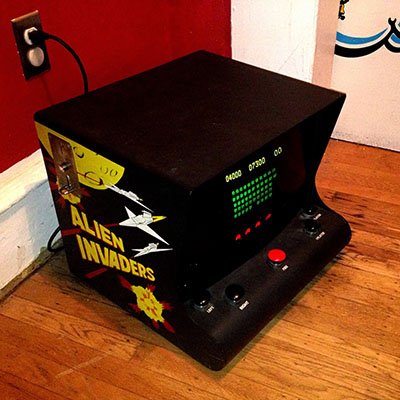
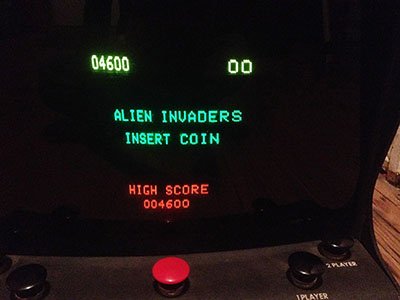
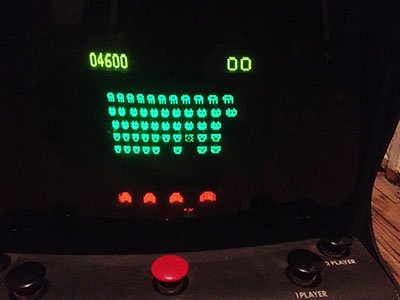
There are a few things that stand out here, first of all the 6502 CPU, meaning it’s definitely not running Taito Space Invaders code, that used an 8080 CPU. Second of all, the cabinet, it’s tiny, as is the display (which is black and white with a colour overlay attached to the screen)
The manufacturer of this unit is unknown, we’re told the PCB is etched with ‘Forbes’ so that’s our best guess. When it was manufactured is also unknown, externally it manages to look almost like some retro-contemporary item, but chances are it’s not much newer than the original Space Invaders.
Emulation also highlighted something else that you can maybe tell from the original photos. The screen resolution is very low, 128×128 pixels, something you’d associate more with a handheld device than an arcade machine. I did some of the emulation work, although the game jumped off into the weeds as soon as you generated an interrupt, Mariusz Wojcieszek noted that by simply returning in such a situation the game would run fine, so it’s possibly some kind of protection (Kale speculates that it’s a PROM) Maybe there is some other purpose to jumping there, like the address bus bits signalling some other hardware, I’m not sure. We could probably do with some clear PCB pictures to see what’s there to either confirm or rule out various theories.
The sound isn’t emulated, again we don’t know what generates it at this stage, could be discrete like the original Space Invaders, but without further PCB images I really don’t know.
Unlike Taito’s Minivader (which was actually just a cabinet test board) I think this was intended as a full ‘for arcade use’ game, the tiny resolution actually makes it more of a Mini-vader than Mini-vader itself tho :-) The game plays well and is a respectable effort to file with the other odd releases based on Space Invaders using unexpected hardware. (I think the only other one with a 6502 is ‘Attack UFO’ but that again is very different hardware, AFAIK based on similar hardware to the Commodore home systems)
Anyway, here are some screenshots of Alien Invaders running, the colour overlay positions are guessed based on the screenshots
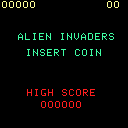

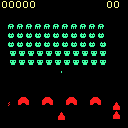
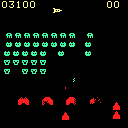
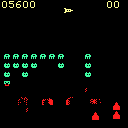
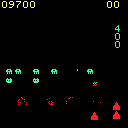
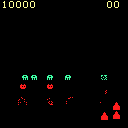
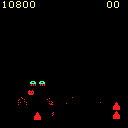
Thanks again to Seth Soffer for this contribution, and if you’re reading, more PCB info / high res pictures would really be appreciated :-)
Why in this article, but not others, is there a bar that expands on hover? There are four entries, one is the dashboard which I don’t think you want us trying to access.
Woops…that bar went away after my post. I guess you can only see it when there are none…I reckon that should be looked at.
it’s on every page, it’s part of the footer, but yeah, I’d rather not have a link to the admin panel login screen there so I’ve removed those items.
I was mucking around with the sound a bit. The sound is definitely going to address 2000 and it does make some noise when hooked up to a dac, but I couldn’t get to sound right at all (or even close)
mame finally goes micro !
Forbes Enterprises, apparently.
http://forums.arcade-museum.com/showpost.php?p=2879585&postcount=12
Many other cab photos in that thread.
Forbes Enterprises? Hmmm…
This 2012 auction in Rhode Island shows a “Black Jack” game from them as well.
http://forums.arcade-museum.com/archive/index.php/t-244623.html
Posters in Massachusetts, parts from Massachusetts, auction in Rhode Island… sensing a New England theme here.
Haven’t seen datecodes from chips on PCB yet, but assuming it comes from the same era as Space Invaders… it may be coincidence but it seems there was a company called “Forbes Enterprises, Inc.” from North Billerica MA, in business from 1978-1983.
http://corp.sec.state.ma.us/CorpWeb/CorpSearch/CorpSummary.aspx?FEIN=000136606
There is some information here regarding its dissolution/discontinuance here, I think:
https://archive.org/details/reportofattorney1982mass
http://archives.lib.state.ma.us/bitstream/handle/2452/43672/ocm01756784-1982.pdf
Yes, bankruptcy. Now to prove that they were responsible… Might be the PCB manufacturer and not the game developer if anything at all, though.
Research also shows a Forbes Engineering, Inc. and a Forbes Manufacturing, Inc. registered to that address.
http://corp.sec.state.ma.us/CorpWeb/CorpSearch/CorpSummary.aspx?FEIN=000016113
http://corp.sec.state.ma.us/CorpWeb/CorpSearch/CorpSummary.aspx?FEIN=000161961
Okay, well, they are confirmed the Black Jack machine mfg.
http://tobaccodocuments.org/nysa_ti_s3/TI21431951.pdf
“p. 74 –
FORBES MANUFACTURING COMPANY
(Coin operated Black Jack Machines)
Faulkner Street
No. Billerica, 01862
John Walsh, President
883-4689”
All of the Forbes research is definitely just barely possible and I could be way off base.
Its former location is an EPA Facility of Interest: http://iaspub.epa.gov/enviro/fii_query_detail.disp_program_facility?p_registry_id=110008407688
[EDIT] Quite possibly related? http://www.forbesengineering.com
All I can do so far…
I’ve added sound
Good Work Robert!!!
Nice and great job
Far more interested in seeing more pics of the boards in these things.
Also, while not entirely mame related, Eduardo Cruz has posted up an interesting announcement about Capcom’s Z80 Kabuki CPU:
Wooooo. Great news about the Kabuki chip! I was waiting for it from a long time. This way Mame could support the reale 3D Soung in CPS2 boards that use the Kabuki.
BTW @Haze. Do you know if there are commercial emulators (for example the official retro compilations by Capcom, Sega and so on like Capcom Arcade Classics) that emulate games better than Mame? I’ve always thought that SWH wait for Mame to emulate games and only then they actually make an official emulator. For example Capcom should have the resources to actually emulate the Kabuki chip but I don’t think they actually did it.
Capcom would have little interest in emulating the Kabuki chip – proper emulation is for hobbyist projects like MAME. Even with CPS2 fully cracked and understood in MAME the official licensed ports still use hacked / decrypted roms, tiles in easier to decode that are ready to upload to the gfxcard formats etc.
With a commercial emulator your priority / goal is ‘make the game work in a way that will be acceptable to most paying customers’ If that goal entails the use of countless hacks, and even HLEing large parts of the game code (or more often, the audio hardware, replacing music with samples etc.) then it gets done that way.
It’s true that more often than not it takes MAME emulating something and figuring out the hardware before there are any official commercial emulators, and that often those emlators use MAME as a reference, but they’re not really interested in implementing anything beyond what is visible to the end user, and even then sometimes choose to change it to give an ‘enhanced’ experience rather than the original one.
This is why I’ve said that MAME has little to gain from commercial emulators, they have different goals.
Btw, Kabuki has nothing to do with ‘3d sound’ anyway, it’s an encrypted Z80, we already ’emulate’ it, if we didn’t the CPS1 Qsound games would have no sound at all. Emulating the fake ‘3d’ sound of Qsound will require emulating the Qsound chip (that is decapped / dumped – qsoud.bin) as a CPU, and using that to process the audio. Right now there are bugs in the CPU core that handles it, and possibly still errors in the decapped ROM preventing that from happening.
Actually with Qsound Capcom usually remove the Qsound screens from any official ports, so there’s probably a licensing issue with the technology that prevents them from using it in official ports anyway.
QSound does exist in the Saturn ports; they use the SCSP’s DSP to perform the processing. There was also a PSX version of the tech from QSound Labs but you had to keep multiple pre-processed versions of each sample in the sound RAM and pick which sample to play based on the QSound 0-32 “QPan” parameter. (IIRC 0 was straight left, 8 was straight ahead, 16 was straight right, and 24 was straight behind you, but that was 20 years ago now). No games that I know of actually had all 32 versions of each sample, so the HRTF effects didn’t work as well as the Saturn version.